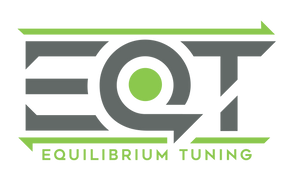
We're often asked about the Burbles / Crackle options available for our tunes, which option they should select, and if there are any drawbacks or if any damage can occur.
EQT Burble Options
Burble Mode selection is dependent on the Transmission Shift Mode for DSG Vehicles, and Drive Mode for Manuals
By Default the transmission is in Normal / Drive mode. Regardless of if you shut the vehicle off in Dynamic mode or not, while it may read "Dynamic" on your instrument cluster, this is what we refer to as "Fake Dynamic." To truly set your vehicle into Dynamic cycle your drive select options all the way back to Dynamic.
Burbles in Normal Mode
- The transmission is in Drive (D)
Burbles in Sport Mode
- The transmission is in Sport (S)
Effects on your Vehicle / Potential Damage
I'm going to break this down into a couple sections, one is going to be volume, the other is potential damage.
| Equipment | Volume | Damage |
| Original | Minimal / Muffled | Not good for the highly dense catalyst material and may reduce it's life and/or cause damage. |
| Aftermarket | Highly Noticeable / Loud | Negligible / No Damage |
Due to how this feature operates, engine braking and fuel mileage will be decreased with this option engaged.
The Tuning element
First we need to discuss what causes the "burbles" or whatever you prefer to call them.
Burbles / Crackles / Pops & Bangs, are achieved by increasing the fuel overrun delay and retarding ignition timing to move combustion events.
Burbles are an OEM Feature in Rest of World (RoW) vehicles, and EQT utilizes that factory programming to produce the desired result while keeping OE safeguards to prevent damage.
Do you offer a more aggressive burble option?
Often customers ask for an "aggressive" burble file, while it is possible to make the effect more or less aggressive it serves no benefit and would require a custom file to do so.
What does this mean?
Essentially the fuel injector is on a timer, from the time you let off the throttle until the injector fully shuts of. This time is so small that it is measured in milliseconds which is one thousandths of a second.
Some people believe that the injectors turn off instantly and that is the difference, however that is simply not true. If the calibrator were to turn the injectors off instantly with a 0ms delay time, every time you let off the throttle the car would jerk or lunge leading to a very poor driving experience.
When we calibrate a tune for Burbles we're simply lengthening the existing timer's value by a certain amount that we deem acceptable. While there are a few other changes involved to fueling, this is the primary change and often "crackle" tunes are referred to as "overrun" tunes.
Next we need to focus on the ignition timing retardation.
During throttle off conditions the vehicle will lose load and maintain RPM due to the mechanics of the engine, so we can target these areas of Low load and higher rpm to retard the ignition timing. Essentially moving the timing events to occur late which moves combustion into the exhaust manifold / downpipe.
The combination of heat, late ignition, and additional fuel is what creates the burble effect.
Things to Consider
OEM VWAG goes to great extents to prevent the catalyst from being damaged and heat it up quickly, they accomplish this with the SAI System, Valve Overlap Tuning and other systems
The SAI System pumps fresh air into the exhaust stream during cold start when the car is in Warm-Up Fueling Enrichment. This is done to lean out the fuel mixture after the cylinder to accelerate the heating of the catalyst to increase its efficiency
Often VWAG uses the Variable Valve controls to control exhaust temperature by creating additional valve overlap to send inert/neutral gas towards the catalyst to cool it
Thanks for reading!
- Dave At EQT.

